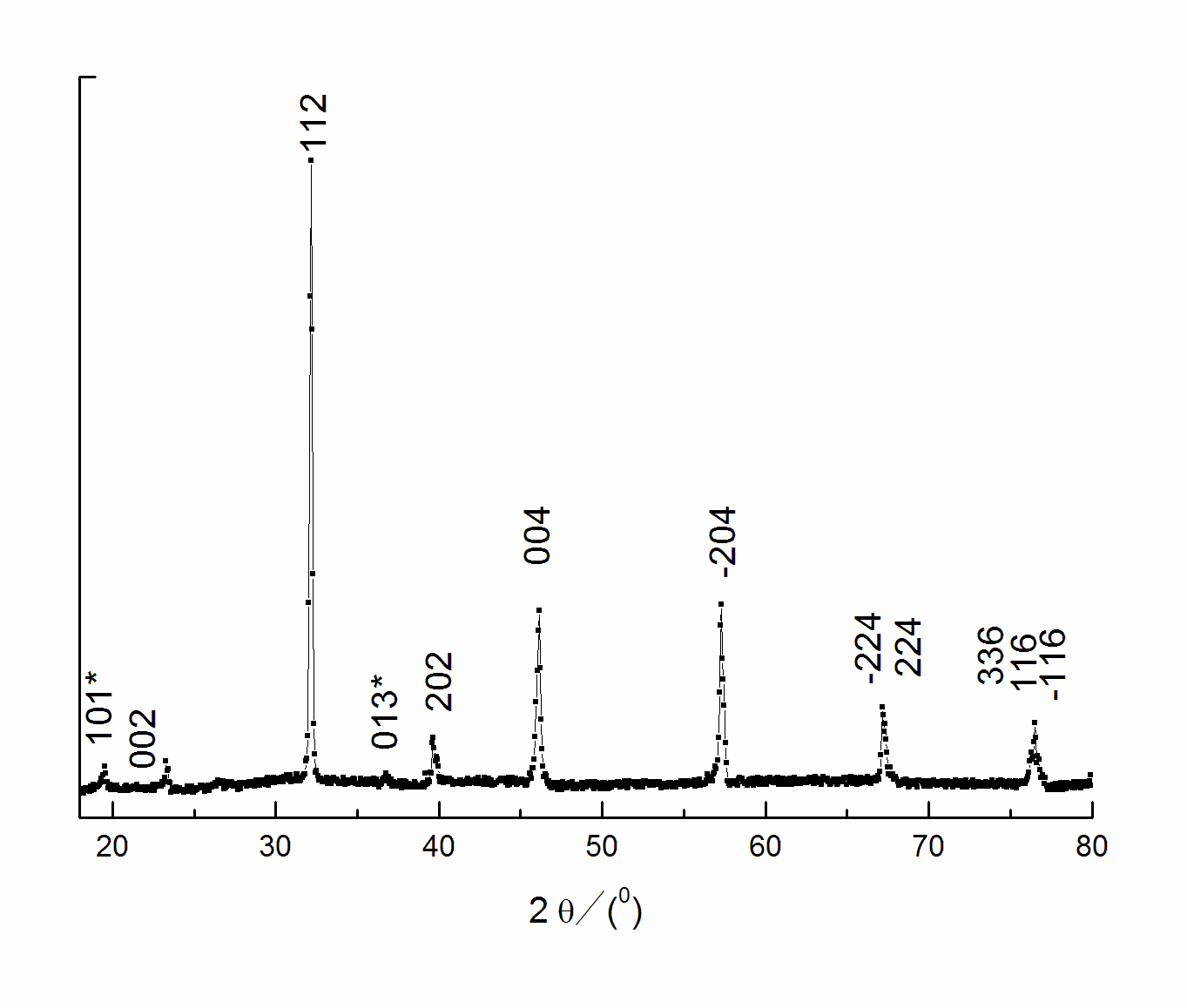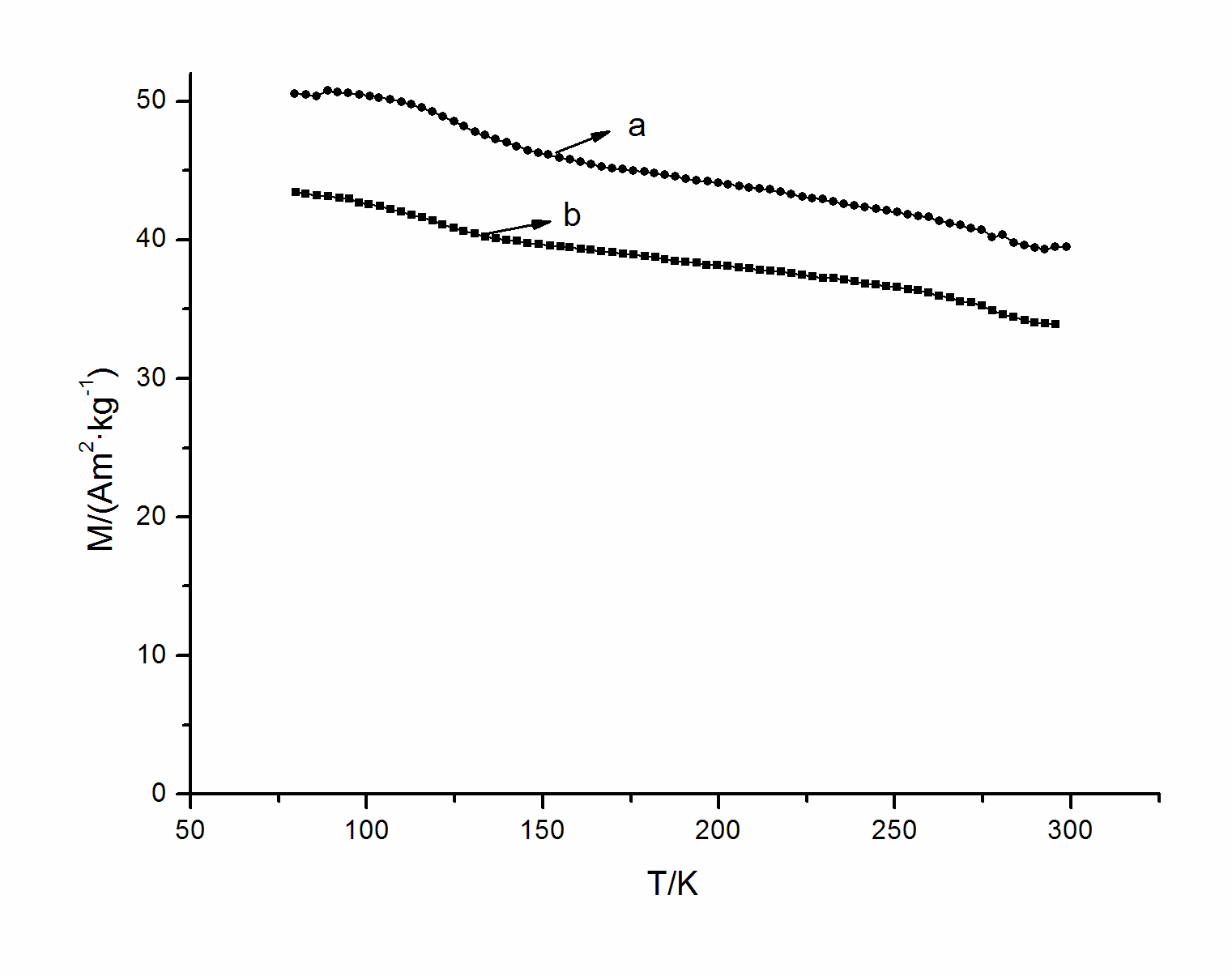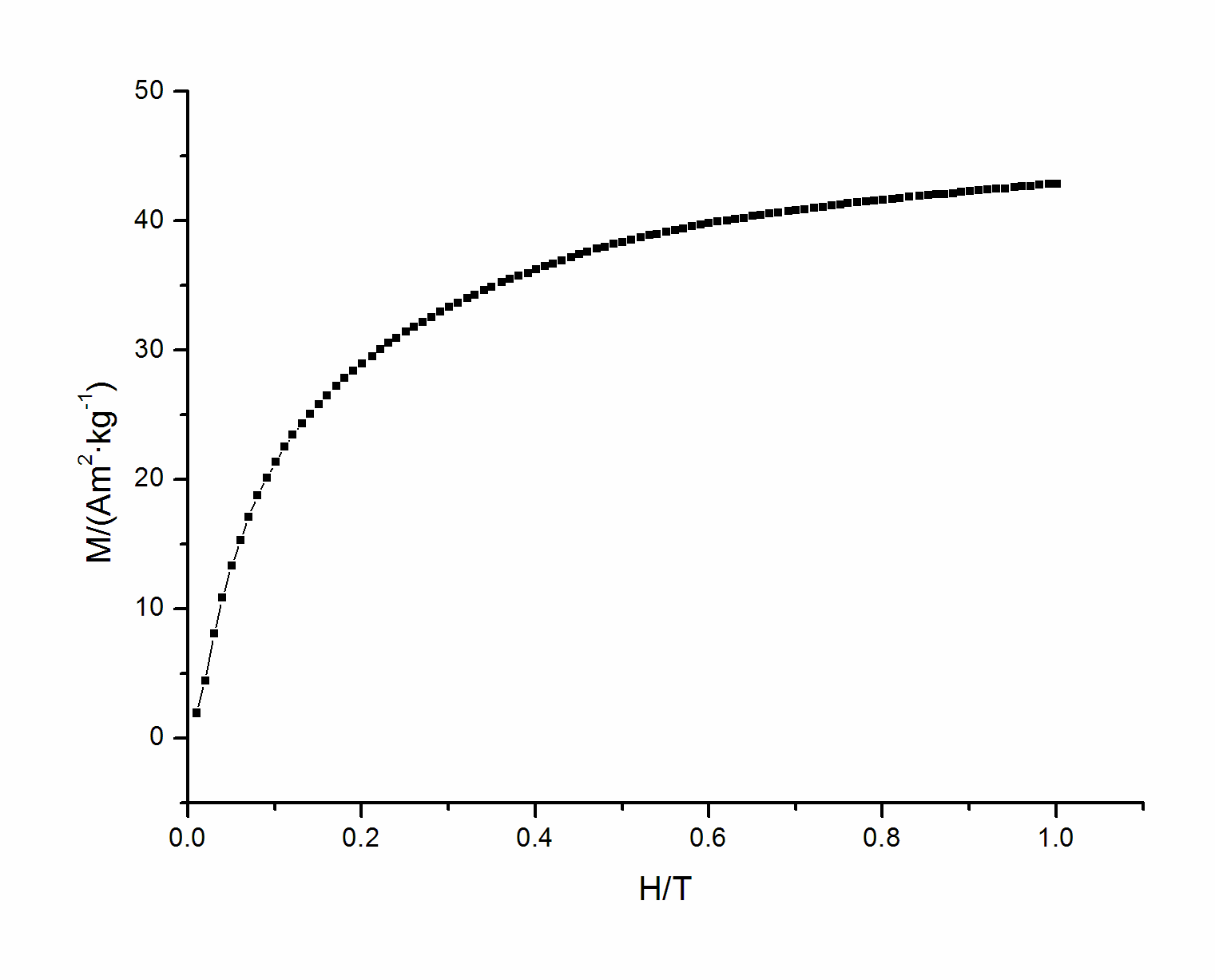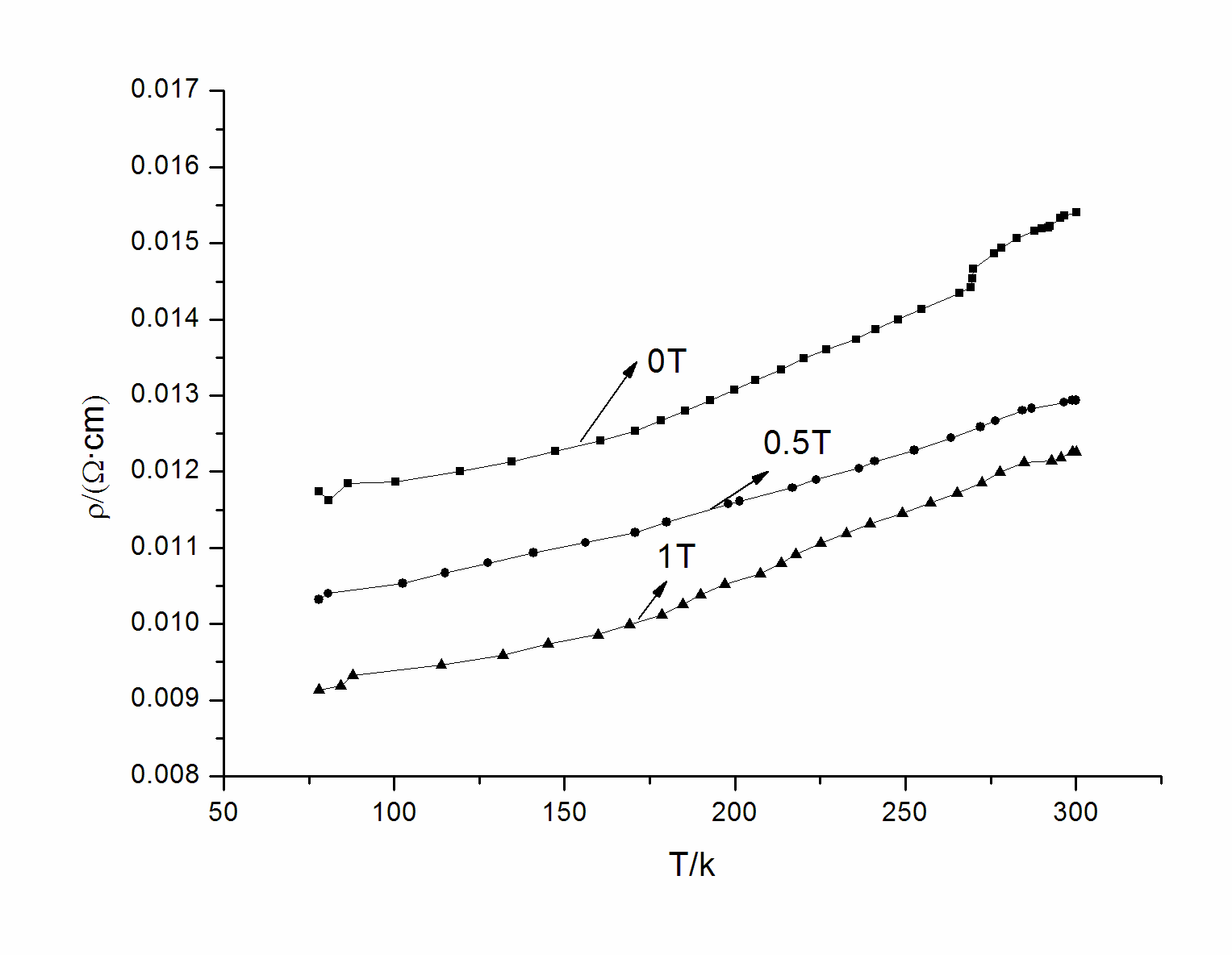http://www.chemistrymag.org/cji/2009/114020ne.htm |
Apr.1,
2009 Vol.11 No.4 P.20 Copyright |
(College of Chemistry and Environmental Science, Hebei University, Baoding 071002, China)
Abstract The double-perovskite Sr1.1K0.9FeMoO6
ceramics have been successfully synthesized. The structural, Curie temperature and
transport properties of this compound have been studied. Its structure belongs to
monoclinic system with P21/n space group. The magnetic moment is high and
slowly reduced with the increase of temperature, and large magnetoresistance of the sample
is found under 0.5 T and 1 T field.
Keywords double-perovskite Sr1.1K0.9FeMoO6
compound; large magnetoresistance; magnetic properties; crystal structure
1 INTRODUCTION
In recent years, double-perovskite oxide
materials have been concerned by the scientists due to the discovery of magnetoresistance
effect at room temperature of double perovskite compounds Sr2FeMoO6[1-3]
and Sr2FeReO6[4]. Fe / Mo double-perovskite compounds
have more obvious magnetoresistance effect at room temperature and higher Curie
temperature than other known magnetoresistance materials, consequently, they have become
the most likely new materials to be used as the magnetoresistance materials at room
temperature[5]. The double-perovskite Sr2FeMoO6 has an
ordered structure with alternating localized up spin Fe3+ (3d5; t32ge2g)
and itinerant down spin Mo5+ (4d1; t12ge0g).
The parallel magnetic moments of Fe3+, antiferromagnetically coupled with the
spins of Mo5+ induce an ideal saturation magnetic moment (Ms) of 4 mB per
formula unit (f.u.)[6]. In order to explore the influence of doping on
magnetoresistance and obtain better magnetoresistance effect at room temperature, a lot of
investigations on cationic doping at Sr site have been done in double-perovskite A2FeMoO6
compounds (where A is the alkaline-earth metals). For example, it was reported that the
substitution of La3+ for Sr2+ in Sr2FeMoO6
promotes a rising of the Curie temperature (TC) and a decreasing of MS
as doping level increases[7], and Kim et al. found that the replacement of Ba2+
by a small amount of K+ in Ba2FeMoO6 reduces the TC[8],
and it was also reported that the substitution of Ba2+ and Ca2+ for
part of Sr2+ also reduce the TC[9]. With the La3+
or K+ doping in A2FeMoO6, carriers doping are also
existence in these materials.
References on K+ doping at Sr site in Sr2FeMoO6
have not been reported until now, in this paper we investigate the structure, magnetic and
magnetoresistance properties of the double-perovskite Sr2FeMoO6
compounds with K + replaces 45% of the Sr2 +.
2. EXPERIMENTAL
The polycrystalline sample Sr1.1K0.9FeMoO6
has been synthesized by standard solid state reaction technique. The raw materials, SrCO3,
K2CO3, Fe2O3 and (NH4)6Mo7O24· 4H2O, of
high purity (more than 99.99%) were mixed by hand in an agate mortar for at least 40 min.
Then it was pressed into pellets under 10 Mpa pressure for 1 min, following preheating in
air at 800 oC for 8 h. The calcined mixture was pulverized and pressed into
pellets. The pellets were sintered at 800 oC for 8 h and 900oC for 9
h in a stream of 4.8 % H2/Ar, respectively. Phase analysis and characterization
were carried out by X-ray diffraction using CuKa radiation with a graphite
monochromator on Rigaku model D/max-2400 X-ray diffractometer.
Temperature dependence of magnetization curves was measured by a
vibrating-sample magnetometer (VSM) in field of 0.5 T over the temperature range 80-300 K.
Isothermal magnetization curve was performed on VSM apparatus. Transport properties were
determined by a standard four-probe DC method in the temperature range 80-300 K.
3. RESULTS AND DISCUSSION
The reaction products were obtained as black and well crystallized powders. The XRD
data of sample were collected at room temperature and the patterns are shown in Fig. 1
which shows that the sample is single phase. No impurities were detected based on XRD
pattern. The diffraction peaks could be indexed in the monoclinic system with space group
P21/n. The lattice parameters are measured by pirum program and found to be:
a=0.5883 nm, b=0.5676 nm, c=0.7886 nm and

Fig.1 X-ray diffraction pattern of Sr1.1K0.9FeMoO6 sample Magnetic moment measurements made as function of temperature M (T) on warming the Sr1.1K0.9FeMoO6 sample from 80 K to 300 K in a magnetic field of 0.5 T are shown in Fig. 2. Curve (a) in Fig. 2 shows the M–T curves with the process of cooling in magnetic field, while curve (b) in Fig. 2 in zero field. It is evident to see from the M–T curves that the magnetic moment of sample with a magnetic field in the process of cooling (a) is higher than that without a magnetic field (b), the reason seems to be as follows: The crystal structure of double-perovskite A'A''B'B''O6 can be viewed as a regular arrangement of corner-sharing B'O6 and B''O6 octahedra, alternating along the three directions of the crystal, with the voluminous A' and A'' cations occupying the voids in between the octahedra. But the B'O6 and B''O6 octahedra will tilt to give rise to fitting space for A' and A'' cations, in the case of the mismatch between the ionic radii of A' and A'' ions is large. The tilting will leads to deflections of B' and B'' ions spin aspects, and some glass state will be produced which result in the decrease of effective magnetic moment. The consistency of B' and B'' ions spin aspects can be increased and the glass state can be reduced by an applied magnetic field on the sample in the process of cooling, consequently, the magnetic moment of sample with a magnetic field in the process of cooling is higher. It can also be seen from Fig. 2 that the magnetic moment reduces slowly with temperature warming from 80 K to 300 K and no magnetic transition temperature appears in this temperature range. This indicates that the Curie temperature of Sr1.1K0.9FeMoO6 sample is higher than 300 K. We calculated that reduction rate with temperatures of magnetic moment of the sample is 0.050 Am2/( kg· K)(a) and 0.043 Am2/( kg· K) (b) from 80 K to 300 K.



Fig.4 Temperature dependent resistivity registered upon warming in zero, 0.5 T and 1.0 T magnetic fields
4. CONCLUSIONS
We have successfully synthesized and investigated the structure, magnetic and
electrical transport properties of double perovskite Sr1.1K0.9FeMoO6
specimen which structure belongs to monoclinic system with P21/n space group.
The magnetic moment is high and slowly reduced with the increase of temperature, and
thermal magnetization indicates that magnetic transition temperature of this compound is
above 300 K. The net magnetic moment per unit formula in the direction of the
magnetization is 3.25 μB. The
resistivities are monotonously increasing over the temperature range from 80 K to 300 K
under zero, 0.5 T and 1.0 T magnetic fields. Large magnetoresistances of the sample are
found under 0.5 T and 1 T field, respectively.
REFERENCES
[1] KOBAYASHI K I, KIMURA T, SAWADA H,
et al. Nature, 1998, 395: 677-680.
[2] SARMA D D, SAMPATHKUMARAN E V, RAY
S, et al. SolidState Commun, 2000, 114: 465-468.
[3] SARMA D D, MAHADEVAN P, SAHA_DASGUPT A T, et al. Phys Rev Lett, 2000, 85:
2549-2552.
[4] KOBAYASHI K I, KIMURA T, Tomioka Y, et al. Phys Rev B , 1999, 59: 11159-11162.
[5] WANG Z C, CHENG S J, ZHU L N, et al. Journal of China J iliang
University(Zhongguo Jiliang Xueyuan Xuebao), 2006, 17(4): 330-332.
[6] HUO G Y, LIU S, WANG Y, et al. Hebei University Journal (Hebei Daxue Xuebao),
2006, 26(3): 274-277.
[7] NAVARRO J, FRONTERA C, BALCELLS L, et al. Phys Rev B, 2001, 64: 92411-(1-4).
[8] KIM J SUNG J G, YANG H M, et al. J Magn Magn Mater, 2005, 290-291: 1009-1011.
[9] KIM B G, Hor Y S, Cheong S W. Appl. Phys. Lett, 2001, 79:388.
[10] BALCELLS LI, NAVARRO J, BIBES M, et al. Appl. Phys. Lett, 2001, 78: 781-783.
霍国燕,施鹏斐,张红蕊,王小晴
(河北大学化学与环境科学学院,河北保定 071002)
摘要 合成了双钙钛矿型氧化物Sr1.1K0.9FeMoO6,并对它的结构、电和磁性质等方面进行了研究.实验表明,此化合物的晶体结构属于单斜晶系,空间群为P21/n;具有较高的磁化强度,磁化强度随温度的升高缓慢减小;外加磁场为0.5 T和1 T时均表现出明显的巨磁阻效应.
关键词 双钙钛矿化合物Sr1.1K0.9FeMoO6;巨磁阻效应;磁性;晶体结构